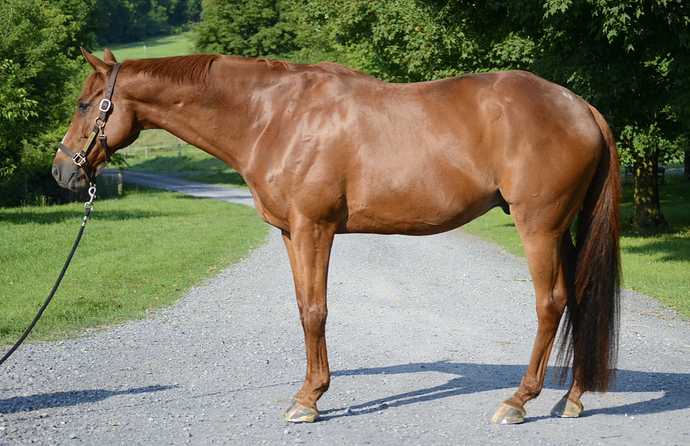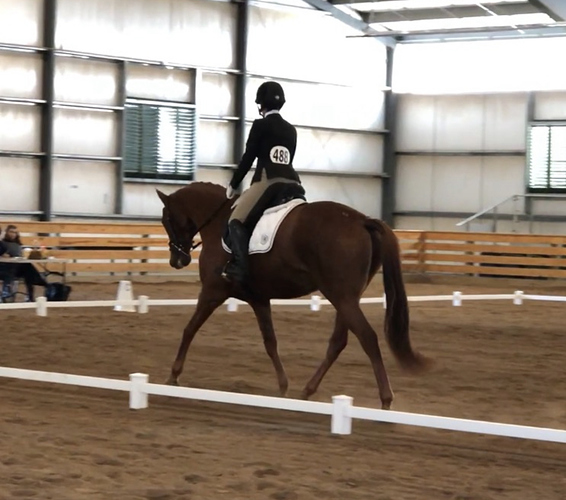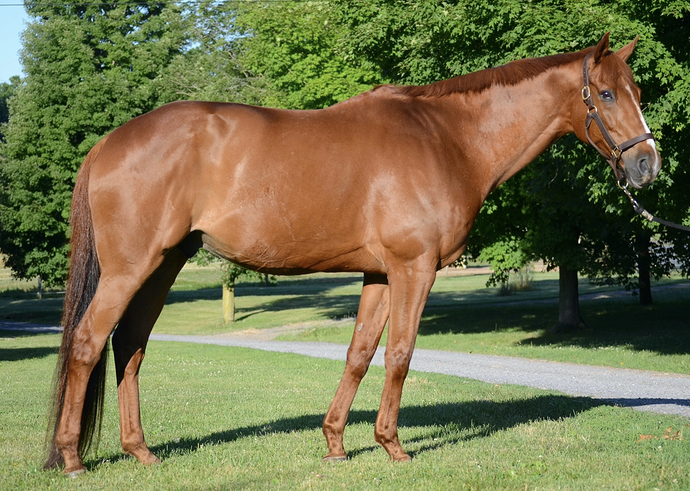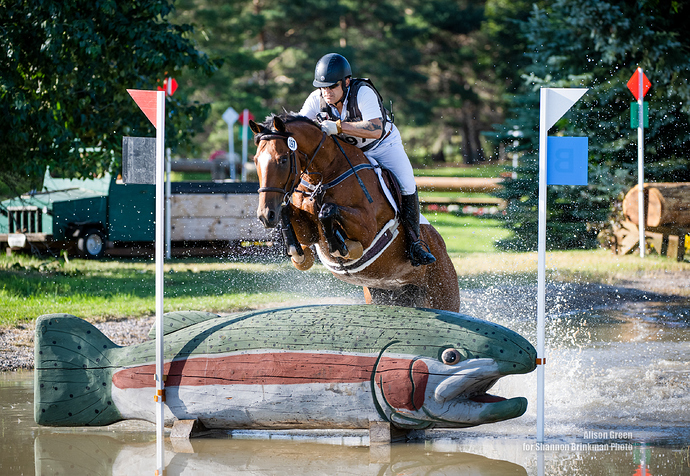Okay 
Both dressage and hunters have evolved to have judging criteria that favor warmbloods over other breeds. In dressage it’s the huge extended trot and “quality of gaits” being increasingly important to the scoring rather than things like collection and piaffe etc to the extent that baroque horses like Lipizzans and Andalusians no longer seem competitive. In hunters, it’s setting the lines to favor a bigger slower horse.
Both of these judging criteria have evolved over time to favor the preferred horses. There’s nothing inherently written in stone about any sports competition. When I watch pro mens teams play basketball it doesn’t even remotely resemble the game we played in high school whereas womens college basketball is clearly the same game with the same tactics and moves.
There are breeders all around the world producing tens of thousands of TBs to go racing. Once that career ends, many, many thousands go on to a successful second career in multiple other disciplines.
There are breeders all around the world producing tens of thousands of WBs to go into multiple disciplines. They tend not to have a second career and no one tests them by racing them.
Versatility is characteristic of TBs.
I had to laugh at the person who repeated the “TBs are weedy and stick legged and so on” story that always, invariably, comes up in these discussions. Sure, some are, but I’ve seen more that aren’t, honestly. In my barn right now we have several seriously thick, big-bodied, big-footed, just big all around OTTBs. All over 17hh, wearing size 84 blankets, etc.
These are event horses and they are built to jump over big tracks, and all of them are either upper level or moving well along that path. One of them collects bonus points when he steps into the dressage ring because he is so elegant. He could 100% do the hunters, along with a couple of other TBs in my barn who have that flat-kneed movement. My good friend’s TB is too uphill to do the hunters but he sure as hell could be a competitor in the jumpers! Crafty, catty, can sit and jump up or gallop and jump across, he would absolutely do well in the AOs. My trainer’s UL TB has a neck that makes my young WB’s neck look like a pencil, and he has just a powerhouse jump.
Someone else mentioned that UL event horses are WBs, but nearly all of them are at least half TB. My trainer’s young horse is half TB and half Oldenburg- purpose-bred to event. So he’s got the fancy movement and a very round WB jump but he has the heart and stamina of a TB. Perfect mix.
But, yes: OTTBs take time to develop, and if you get a trainer/rider who doesn’t know how to do this, it’s not going to be pretty. I think the people who know how to bring along an OTTB correctly aren’t found very much in the H/J ranks anymore, which is a shame but makes sense from a business model point of view. We got a TB mare in many years ago whose owner wanted to do the hunters. The mare has the movement and a gorgeous gappy jump, but the owner didn’t know how to ride this sort of horse and she ended up being scared of her. She sold her to one of my trainer’s clients, a kid who wanted to event, and now the mare is an eventing machine. Her owner is off to college, so her current lease is shared by a newbie adult and a kid coming up from ponies. She’s a schoolmaster at this point. The mare could have easily been a really nice hunter, but just didn’t have the right person for success. That, unfortunately, seems to be typical.
Why did I even bother? I could have gotten a WB. 
Seriously, I understand the point folks are making about the perceived advantages of a WB. However, I truly believe that a good TB, properly developed and trained, can play the game right up there with the best. But many are correct, very, very few people are able and willing to take that time.
It bothers me greatly that TBs are overlooked. As a breed, they have more desire and drive to go forward than any other breed except Arabian. It is in their DNA to move forward and be smart about it. Many folks in the modern industry can’t understand that. It is very hard to actually sit there and not do anything other than support the ride because the horse will instinctively take care of everything if you let them own it.
@blondewithchrome, He has Intentionally in his pedigree twice. Supershorty’s lovely mare and my very beefy, correct gelding are related as well through In Reality. When I was showing very successfully a few years ago, I was always asked what kind of WB he was, and if he was for sale (NO!, NEVER!). I’d say racetrack WB.
I am now too crippled by my MS to play the competitive games on a horse.
But if I were physically able–of course I would be riding an Arabian. If however I wanted to get really serious as a competitor as a hunter, a show jumper, a upper level 3-Day horse or as a field hunter over really stiff country there is no doubt in my mind that I would find a suitable competitive horse in the TB breed. Why ride anything else when I could get all I wanted in ONE horse and be competitive in various horsie “games” and I could trust to keep going even when the going gets really, really rough.
I want a horse that can think for itself in an emergency. I’d want a horse that can last a full day.
I’d want a horse always looking ahead for the next exciting challenge. I’d want a horse who could really get into the games and have that deep desire to win.
IMHO Arabians are the best. The TBs can be even better for less than 50 to 100 miles in one day physical challenges that require a horse that can jump higher and run faster than an Arabian can.
I used to be able to ride a horse who can really “fly”.
who’s judging, the judge of yesterday, or the judge of today?
If the judge of today is looking for the lofty suspension-filled movement of the WB, most TBs will fall short of that.
That depends entirely on the class and the standards to which it is judged.
what QH? HUS? Foundation? Reiner? Cutter?
The HUS QH is basically a stereotypical TB, tall, lean. Foundation QHs are the “bulldog” of the breed. Reiners and Cutters are sort of in between, and the GOOD ones are really nice, functionally correct, athletic horses
It is amusing to me that anyone would suggest that TBs can’t make the step. That is one thing that TBs have been bred to do and continue to be bred to do: have a big stride. To say that TBs can’t make the step is as absurd as suggesting that warmbloods of Heinz 57 breeding all can. Neither is true. There’s such a huge variety in both types.
I had a small junior hunter in the 90s (when we only had 3’6) She was a very classic TB type, 15.3+, and when I say she walked the lines I mean, I jumped in, sat up and said whoaaaaaa at the big shows. I also was showing a young Holsteiner in the Childrens at the same time. Now he had zero problem making the step, but his stride was nothing like hers - and he also had a few inches on her.
Making the step of course can also be the result of good training and riding. For some it’s their natural way of going, but many horses (and riders!) need to learn to allow it, and that goes back to what many have already suggested: being able to train a horse to allow that natural step to open up is a skill that not everyone has.
I totally understand what is meant by “they can’t make the step.”
The standard has changed. We don’t want a flat, gallop-like stride anymore. We want a big, suspension-filled canter down the line that covers ground while simultaneously looking borderline slow and lofty, followed by a springy, very round jump.
TBs just don’t have the generations of selection for that kind of movement and jump like the warmbloods do. They doesn’t mean TBs can’t be lovely movers with lovely jumps. But it’s getting more challenging for them to stack up against purpose-bred sporthorses in a subjective class.
EXACTLY THIS
You do realize that the 90’s was 30 years ago, yes?
There is a rancher on facebook that I follow that takes ottb’s to his ranch and turns them into all-around horses extraordinaire. The horses in his training program are in good flesh. All he feeds is grass hay and pasture. I wish all retiring ottb’s that are sound could go to a program like his. GatetoGreat Thoroughbreds. And no, I’m not affiliated with his operation.
Bless your heart. I’m well aware of my age, thankyouverymuch. I was merely comparing strides of a TB and a WB.
The young Holsteiner from the story from ye olde 90s was still clocking around til just a few (yes really) years ago. So if it makes you feel better about the timing, his stride was also not as long as a TB I’m still riding today, who the Holsteiner lived with for years.
Does that change the size of the respective horses steps? I’m pretty sure comparison between the two horses holds up to time 
But this is the question that frustrates me. Why did the hunter judging criteria change? I would have thought the judging criteria would be the same rules-yesterday and now. It SEEMS judging criteria changed…based in the horse breed itself. Right? That’s what saddens me.
Bless your heart right back. If you were riding junior hunters in the '90s, then I’m older than you are.
My point was that standards have changed in the last 30 years. They’ve changed even in the last 10 years.
You seem to be taking this very personally. I’m glad your Junior Hunter from the 90’s had a big step.
The size of the step did not change. The perception of the pace changed. A more forward pace used to be the norm and was in fact rewarded.





